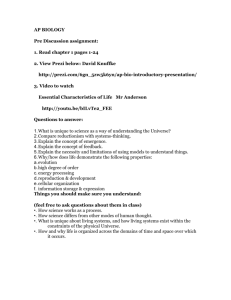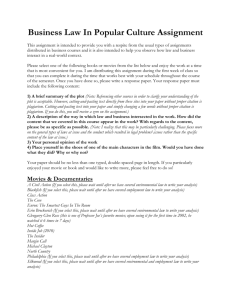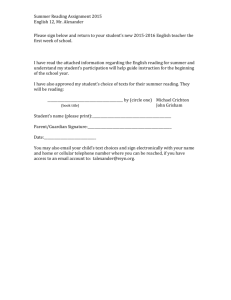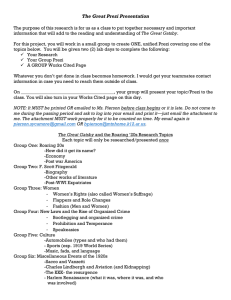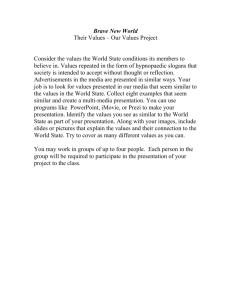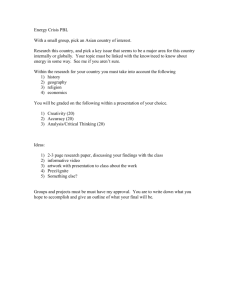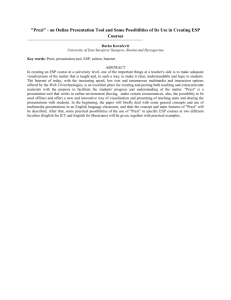Engaging Student Writers with Technology
advertisement
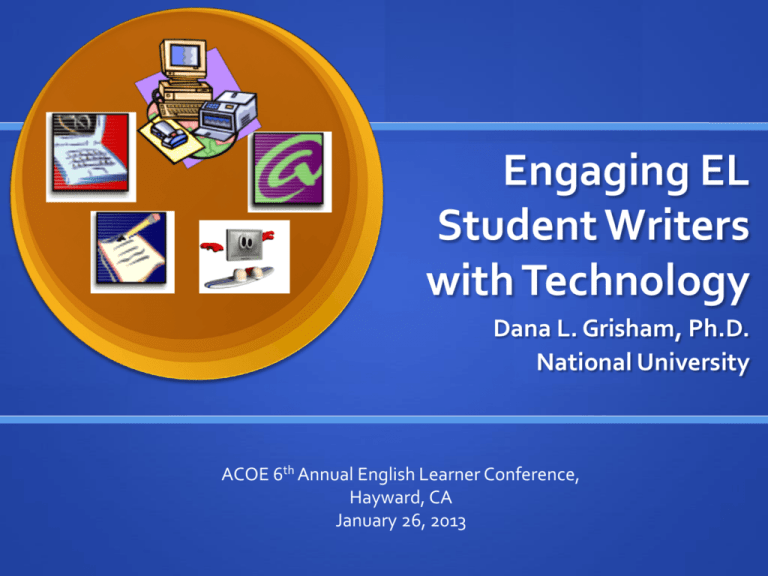
Engaging EL Student Writers with Technology Dana L. Grisham, Ph.D. National University ACOE 6th Annual English Learner Conference, Hayward, CA January 26, 2013 The CCCSS Common Core State Standards (CCSS, 2010) adopted by the State of California (California Common Core State Standards or CCCSS) A call for the integration of language arts (reading, writing, listening, and speaking) into all disciplinary areas A call for the integration of technology into teaching A call for greater text complexity and more independent reading The Millenials What is unique about the 21st century student is that they exercise all their learning modalities [verbal, kinesthetic, visual, and aural] by using and playing with technology. Technology extrinsically and intrinsically engages these students (Grisham & Wolsey, 2012; Grisham & Smetana, in press) Generational Differences Millennials (Born after 1982) Students in grades 6-12 today were born after 1995 They have always worked on computers They almost always have cell phones and iPods An Example Sarah and I go home and she calls me on the phone when she’s ready to log on. We keep the phone conversations going while we log on and decide where to go. We’re always on the talker, but sometimes we go idle to visit other places. I keep telling dad I need a bigger monitor, because I wind up with so many windows open that I can’t always follow what’s going on in each one. Then we do about six different things at the same time. We’ll have my talker open, our ICQ on, we’ll have the role-playing MOO we just joined open, we have our homework open (which I’m pleased to report we both get done at the end of the night and its soooo much more fun doing it this way!), we have the palace open, we have our own private conversation windows open for different friends, and we have our phone conversations going on at the same time (Thomas, 2007, p. 167). Some Statistics 93% of the adolescents surveyed (ages 12-17) used the Internet for social interactions—such as blogging, webpages (for either school or social uses), sharing artwork, photos, stories, and videos as original content, and “remixing” online content to create new texts. However, there are access problems for students that need to be addressed in schools (Grisham & Wolsey, 2006). Technology is an important part of the solution To teaching words and strategies To increasing volume of reading To developing an interest in words New Tools for New Times! Why Technology? CAST’s Universal Design for Learning approach calls for the following: “Multiple means of representation, to give learners various ways of acquiring information and knowledge, Multiple means of expression, to provide learners alternatives for demonstrating what they know, Multiple means of engagement, to tap into learners' interests, offer appropriate challenges, and increase motivation” http://www.cast.org/research/udl/index.html Writing Instruction The Neglected “R” (National Commission on Writing, 2003) Teachers often do not feel prepared to teach writing Teacher preparation programs focus more on reading instruction than writing instruction Writing becomes a “week” (Monday—prewriting; Tuesday— drafting; Wednesday—revision; Thursday—editing; Friday— publishing) Lack of technology resources and support for teachers to integrate technology into their classrooms in a high accountability environment NAEP National Assessment of Educational Progress (2011) is the first to integrate technology into writing (LiteracyBeat) Gaps continue to exist among ethnic groups (as does a gender gap) NAEP NAEP Driving Questions What can we do to improve the writing scores of over 5 million Spanish-speaking English Learners? What can we do to improve the motivation and self- efficacy of these students? What can we do to integrate meaningful technology into our teaching? Definitions Composition may be defined generally as “the action of putting things together: formation or construction” (Google, 2012). Another website (http://grammar.about.com/od/tz/g/writingterm.htm) defines composition as, “The nature of something’s ingredients or constituents; the way in which a whole or mixture is made up.” We like these definitions because, although they are general, they focus on building and generating an end product. Writing is defined as “a system of graphic symbols that can be used to convey meaning (http://grammar.about.com/od/tz/g/writingterm.htm). Multimodal texts exceed the alphabetic and may include still and moving images, animations, color, words, music and sound and consist of web pages, films, and podcasts in addition to print-image hybrids (Selfe & Takayoshi, 2008). TPACK Mishra & Koehler, 2006 Provides a framework for planning to use a technological tool for a learning outcome. A Study of Teacher Candidates Grisham & Smetana (in press) conducted a study with 21 preservice teacher candidates in general and special education. TCs planned and taught a “generative” technology lesson as part of the course TCs integrated technology into their teaching in a way that addressed real students in real K-12 classrooms Tools were suggested, but TCs could use others they heard of or found Findings from the Study Scaffolding TC thinking through a proposal process with instructor feedback helped TCs to think and plan with tech TCs showed remarkable diversity in their choices of tech tools and integration into their teaching TCs initially found TPACK “too abstract” but their choices revealed that they actually used the framework and matched the technology to their teaching objectives. Lessons were primarily generative in nature, but a few were teacher directed/structured Examples of Generative Tech “Lila” and “Neta” taught 4-6th graders at elementary level Learning to write an expository essay by means of a blog They used Wordpress (http://wordpress.org) to construct the blog and Step Up to Writing (Cambium Learning Group) for the writing curriculum They used YouTube videos to introduce two topics and another software (Text2Map) to organize students’ thoughts into digital format TCs demonstrated that students successfully completed the project and were “engaged” by the technology and “21st Century Skills” Example 2 “Elana” used a more teacher directed project with Prezi (http://prezi.com) in her Special Day Class to teach phonemic awareness and phonics Wanted software that was “interesting, but not too distracting” and to take old lessons and make them new and exciting Scanned Zoo Phonics picture cards and inserted into Prezi Projected Prezi onto whiteboard and students chanted sounds and made appropriate body movements Elana now plans to add sight words to the Prezi Example 3 “Avram” taught 8th grade and sought to engage a group of disaffected English Learners, all boys The pullout students developed the “Flamingo Writers Workshop” with their teacher, creating a website on Weebly (http://www.weebly.com) They drew parallel between writers workshop and website construction: Prewriting, Organizing, Writing, Editing, and Revising (POWER) Plan, Design, Create, Register, Inspect, and Publish Technology made the project engaging and increased student self-efficacy TC “Take Aways” 1 Lesson reflections indicate that TCs often became more positive in attitude toward technology integration one “technophobe” changed substantially, stating that the assignment “has certainly helped me understand that students need the enrichment and engagement that technology can provide.” Another student stated, “Technology made everything we did more engaging to the students.” “This project was a great help in getting our students to practice writing and use new elements in their writing in a fun and developmentally appropriate way.” TC “Take Aways” 2 TCs described the deep engagement of low SES students, English Learners, Special Education students, many of whom have poor academic self-images and may resist school or act out. The “learned helplessness” exhibited by some students disappeared as they felt empowered by technology. “Monte” noted, “The learned helplessness that I sometimes encounter with some students in the classroom was nonexistent in the computer lab.” “Jenny” stated, “I observed an increase in individual creativity and a surge of verbal communication between students” as they worked with the technology TC “Take Aways” 3 Technology integration required time and K-12 students required time for exploration of the tool “Carlos” shared, “I forgot that giving the student new technology was just like giving a student math group linking cubes. I needed to provide a time for play and exploration before using the cubes in a lesson. Once I got on board with the students and allowed ‘playtime’, our projects progressed well.” Implications We need support for 21st Century Learning tools and technology integration (funding, technical help, TIME) We need to embrace the need for technology integration and what it will do to help our students We don’t need to do all of it, but we do need to start. Try one new tool integrated into a lesson this year! We need to find “spaces” for this despite program improvement, pacing guides, and directed curricula Our students NEED this because this is what motivates them Multimedia Retelling Martina, the Beautiful Cockroach: A Cuban Folktale by Carmen Agra Deedy Illustrated by Michael Austin Garage Band recordings of character’s retelling PowerPoint book Dana Grisham and Linda Smetana with 7 gr 3-5 children Abuela Martina’s Cuban grandmother, Abuela, tells her to test a suitor’s real nature by pouring coffee on his shoes. “Josephine” talks about how Abuela gives good advice to Martina. Keys to success Read and discussed story beforehand Children chose their character Gave a partial retelling (not the whole thing) Used book illustrations to guide retelling Adult recorded with garage band and created PowerPoint book (scanned images, inserted sounds, text) Resulted in tangible product that was shared digitally and in print For those transitions….FREE RICE http://freerice.com/#/english-vocabulary/1401 Practice with Tools VoiceThread http://www.voicethread.com. Animoto http://www.animoto.com/education ComicCreator http://www.readwritethink.org/files/resources/interactives/comic/inde x.html Edmodo http://www.edmodo.com Glogster http://www.glogster.com Prezi http://www.prezi.com Popplet http://popplet.com Practice with Tools Slidepoint http://www.slidepoint.net Storybird http://storybird.com Strip Designer http://itunes.apple.com/gb/app/strip- designer/id314780738?mt=8 Stripcreator http://stripcreator.com Screencast http://screencast.com Screencast-o-matic http://screencast-o-matic.com Cool Tools for Schools http://wwwcooltoolsforschools.wikispaces.com/Presentations+Tools Toontastic http://launchpadtoys.com/toontastic/ Directions With a partner, choose one tool and explore it for the next 10 minutes. How do you download? How easy is it to navigate? What do you envision you might do with it? (Think TPACK) Be prepared to talk about it to the whole group Additional Resources TextProject http://textproject.org For Our Students: Customization and Choice Contact Dana L. Grisham dana.grisham@gmail.com

